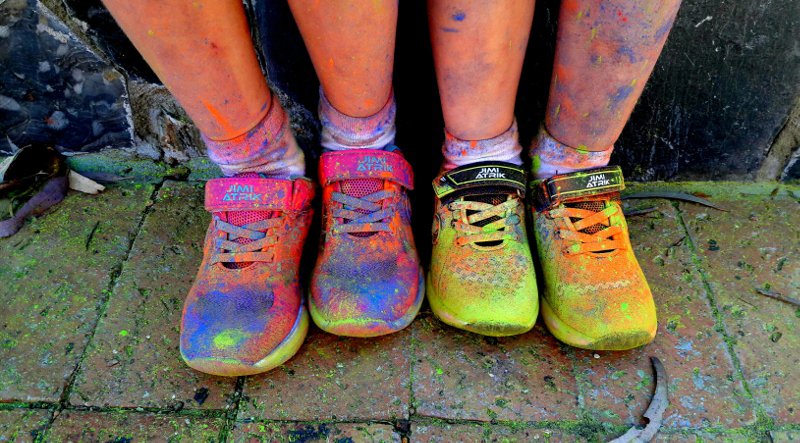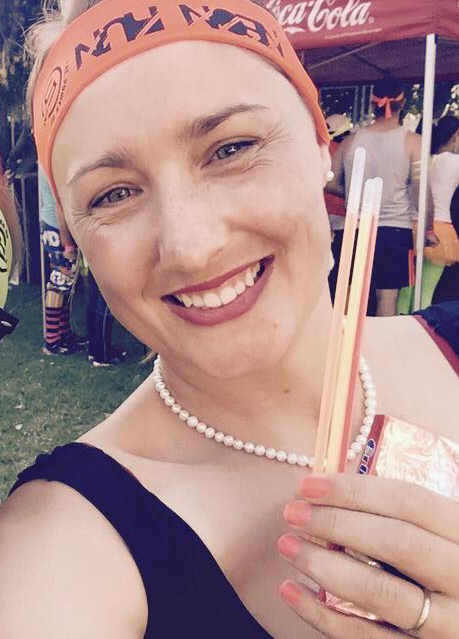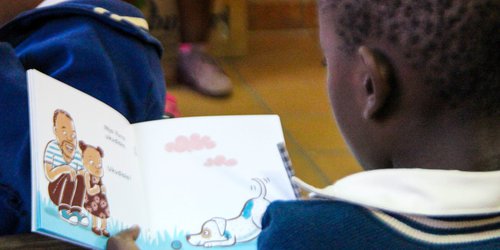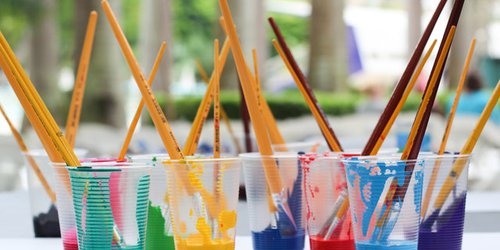How to find the perfect shoe fit for your child
Finding the right pair of shoes for your child can be challenging, especially at a young age where you must buy and retry every so many months. Sometimes I think they should just go barefoot. Now barefoot walking and running has been a hot topic. It is highly beneficial to a child’s development, as it not only helps with shaping of calf muscles and tiny muscles in the feet (to form the bridge), but it also improves balance and proprioception, decreasing the chances of future injuries due to internal factors. Even though there are great benefits to running and walking around barefoot, in a modern lifestyle it is not always practical. So we always try and aim for a shoe that will be as natural as possible for our kids- wich is what we found in Jimi Atrik.
Just this weekend we tested our brightest pairs of Jimi Atrik Shoes at the Cape Town Color Run! The kids had a ball and their light weight, bouncy shoes surely contributed to the fun!
Having tried and tested Jimi Atrik footwear, I’d like to share with you 3 reasons why we let our kids wear these shoes and then 7 steps to find the perfect fit for your child.
WIN some comfy and fashionable shoes for you kids:
Our blog sponsor today is Jimi Atrik Kids Footwear – who recently launched an athleisure footwear range for kids. They are also running a giveaway- where they will be giving away 6 * 20 pairs of shoes- - as they are so generous, your chances to win are good- so go enter! Draws happen every Friday on the Jimi Atrik Facebook Page and the competition ends 6 December 2017. Imagine getting a pair of Jimi Atrik Shoes valued at R400 – R500 for Christmast, for free?

3 Reasons why we are happy to wear shoes (function and aesthetics)
Shoes provide protection from environmental factors
My kids tend to be more out of- than in their shoes and so every day after school it is a struggle to get them across the hot tar road to the car. In winter, shoes can protect us from the cold and dangerous objects. So, shoes can provide some comfort and protection.
Shoes can assist in personal hygiene and health
Footwear can further protect our children’s feet by forming a barrier, preventing infection by contaminants, ring worms, fungi as well as other communable diseases.
It is stylish
My grandmother used to say, tongue in cheek: “vanity knows no pain”. For kids, in my opinion, we should avoid this at all times. I used to cringe when kids wear high heels, and then my daughter got a pair for her birthday (those hard, plastic princess shoes) and I have had an interesting time getting her out of it. She is a natural high heel walker- she can even squat in them. Studies however show footwear needs to be comfortable, allowing kids to be kids (run, play, climb), and further allowing natural growth to take place (and still look fashionable?).
Before you decide, here are steps to follow when you buy children’s footwear:
Make sure that you buy your child the most appropriate shoe for his age and for what your child will be using the shoe for.
If you are buying a shoe for a baby that only crawls, you will only need to buy booties that are designed to keep your child’s foot warm and pretected. If you are buying a shoe for a child who is just learning to walk, you will need to make sure that the child has a shoe that assists with the walking process instead of hindering it.
At home - to save you time or assist in online shoe shopping:
I made the mistake of going shoe shopping with a two-year-old years ago. Little did I know how frustrating this process can be if you are not prepared as almost every brand has a different measurement for each size. I found these steps online and they helped a lot with the preparation for my next shoe shopping spree. Here goes:

Use a piece of paper to measure your child’s foot.
- Place the paper on a surface that is flat and line it up along the wall.
- Draw a line down the piece of paper.
- Place your child’s heel on the paper so that it is touching the wall and then have your child’s big toe and heel centred with the line that you drew.
- Mark the paper at this point. Do this to both feet and compare the sizes.
- You can take this to your shoe store or use it online if your provider has a size chart.
Both feet should be measured, as one foot is usually larger than the other and parents need to buy the shoes that accommodate the larger of the two feet.
4 Properties of a good shoe for kids
The shoes that are purchased for young children need to be breathable, flexible and have anti-bacterial properties.
- Flexible: Studies have indicated in the past that younger children require more flexible footwear because they still have to develop and strengthen their bones and tendons. Therefore, they require a shoe that is flexible enough to allow for freedom of movement, but sturdy enough to offer the required support for stability and balance, without prohibiting proper foot growth. They need flexible soles that will bend and shape with their foot with every step.
- Support: The best footwear offer support in the centre of the shoe to eliminate twisting their feet and give shock absorption and stabilization in the heels.
- Non-Slip: The bottom of the shoe needs to have a textured surface with no-slip properties.
- Easy to put on: It is important to be able to widen the shoes for dressing purposes, therefore shoes with tie strings or Velcro are a great help to parents. Slip-on shoes are great for toddlers to encourage getting dressed themselves until they learn how to tie their laces.
7 Steps to follow to ensure a good fit:
- Snug Fit - The fit of the shoe should be comfortable without falling off. This usually means excluding backless ones. The shoes should be snug enough to stay on without the heel of the foot coming out of the shoe while the child is moving.
- Time of shopping - Plan shopping trips in the afternoon when the feet are the most swollen. It is important to measure the child’s feet during every purchase.
- Stand up - When trying on shoes, children should be standing up, with their weight evenly distributed on both feet and their toes flat in a natural spread.
- When checking the length, there should be around 12 mm of space between the longest toe and the end of the shoe, in order for the toes to spread out for better comfort and stability. Pressing on the top of the shoe will reveal where the toes are located, and whether they are pressed too firmly against the shoe wall. All toes should be able to move freely without crunching together.
- Squeezing the shoe material on the sides will indicate whether the width of the shoe is acceptable.
- The back of the shoe should fit snugly when you insert your finger between the heel and the back of the shoe.
- With their shoes on, the child should stand up and walk around the store for a little while. After taking the shoes off, there should be no marks left behind on the child's feet, assuring no need for the child to go through a ''breaking in'' period of their shoes and allowing them to wear the shoes immediately.
I trust this will help you with your next shopping spree. Have you tried the new Jimi Atrik footwear range? Let us know in comments!
Tanya
